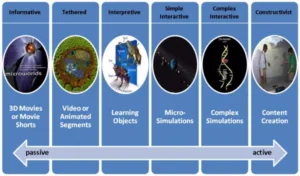I was delighted by reading TI Fellow Karl Guttag’s recent piece on Display Daily entitled VR and AR Head Mounted Displays – Sorry, but there is no Santa Claus. In this remarkable piece, Guttag brings the reader back down to earth on the readiness of VR and AR technologies for the marketplace based on the absence of solutions for the many human factor challenges associated with VR and AR hardware.

Guttag’s article immediately led me to think about my area of specialty—schools and universities—and about another building block of scalability that he did not address, but one that remains an equally significant hurdle to broad adoption of these technologies in schools (or frankly, in any market.): VR content. I wondered: “Is educational VR content ready for prime time in schools?”
Well, I hate to pile on, but it’s always useful to temper exuberance with a stout dose of business reality. Five years ago, I developed a taxonomy of content types for educational 3D content. At that time, in analyzing the available 3D content specifically designed for the educational market, I first recognized that 3D educational content came in a diversity of approaches and design–six flavors, if you will:
In revisiting my taxonomy, I realized that contemporary VR content for the education market today still fits clearly into these same lanes. But here’s the problem: Nearly all of the educational VR content I have seen to date fits only into the first three lanes: video shorts, shorter animated segments, or learning objects. (Imagine simple walkthroughs, immersive field trips, and objects that can be rotated.) Despite their immersiveness, these VR learning opportunities are all passive experiences. (Incidentally, school gatekeepers—such as district administrators, principals, and lead teachers—ferociously fight to keep passive learning experiences out of classrooms.) Yet hardly any VR content in today’s educational marketplace reaches into the more interactive lanes of micro-simulation, complex simulation, and user-generated content. (Micro and complex simulation often work well addressing a ‘wicked’ challenge in education today—the need to teach complex thinking and problem solving, not just teach for memorization.)
So, that’s the stinky elephant in the room. Until this content reality changes, VR will never reach its potential in the educational market; VR will not scale to the level hoped for by the VR industry. Instead, educators will rapidly disinterest themselves in the lower, more passive forms of VR content and move on to other things. I hope the momentum will not be lost.
Now, I know what you are thinking: “haters gonna hate and ain’ters gonna ain’t” is what’s rolling through your head. But I’m no hater, mind you. As an executive board member of the ISTE 3D Network, I’ve been working to advance the implementation of 3D VR into schools. And as the online community manager for the 9000 members of LinkedIn’s Stereoscopic 3D Media and VR Technology group, I continue fighting to keep this agenda on the table. I just haven’t drunk the Kool-Aid. Thanks, Karl. -Len Scrogan

